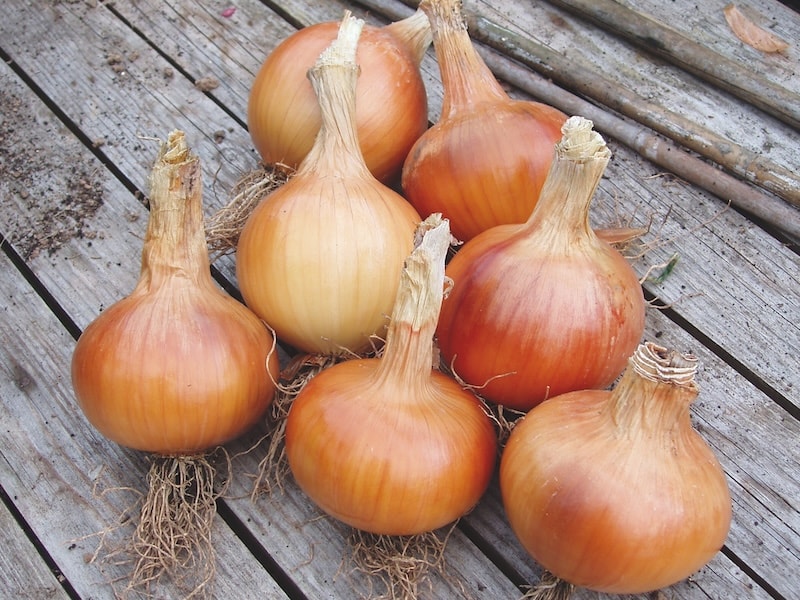Sowing onion seeds or growing your own from onion sets is relatively easy and incredibly satisfying. Here, we’ve brought together the best onion-growing content from the internet, including articles, videos and instagram posts to help you plant, care for and harvest onions at home. Whether you want to cultivate brown, red, salad, pickling or exhibition-sized onions, here are some expert tips to ensure you succeed.
Contents
- Best advice on growing onions from sets
- Best advice on growing onions from seed
- Best advice on planting out onions
- Best advice on onion problems, pests and diseases
- Best advice on harvesting and storing onions
Best advice on growing onions from sets
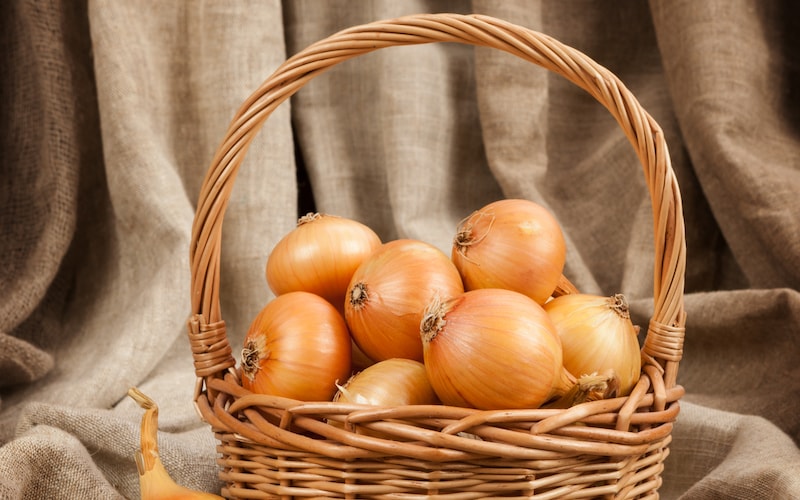
Growing from sets is an easy way to get a crop of pungent, flavoursome onions
Image: Onion sets ‘F1 Centurion’ from Suttons
Novice gardeners can learn a great deal about growing onions from sets from the very informative article Know your onions! – Beginner’s Veg by the ever wise and witty sisters also known as The 3 Growbags. They say onion sets don’t like a fuss and prefer soil without manure. You should plant them with their “little papery noses” just sticking out of the soil, and initially throw a net over them to deter pecking birds looking for nest material.
According to Emma at The Unconventional Gardener, onion sets are so easy to grow, store and use that they make the perfect project for beginners. In her entertaining blog post The Onion Club, she recommends opting for a mild overwintering variety such as ‘Electric’, which can be planted in the autumn and harvested in early summer.
In the north of England, Dan from Allotment Diary is a man who really knows his onions – he’s grown a 10lb-er for exhibition before. In his short, but sweet video Growing Onions: How to get an early start with sets, he shows how he starts off his onion sets in 24-cell trays. Because of the cooler climate where he lives, he grows them on in the greenhouse or polytunnel so they have good strong roots and the soil outside has time to warm up before he plants them out.
Most of the hard work has been done for you when you grow onions from sets and it’s easy to get a fantastic crop, according to Simon at Garden of Eaden. In his detailed article on growing onions he explains how to establish a permanent onion bed – on a sunny site with good drainage – that you maintain well to build up soil fertility and eliminate diseases.
If you’re overwhelmed by the sheer variety of onions on offer, why not check out the Suttons horticultural team’s complete guide to growing this versatile veg. As well as discovering the best varieties to grow from sets, you’ll benefit from our expert tips on planting, harvesting and storing them.
Most people plant their onion sets in early spring for late summer harvesting, but in her informative article: Onions: seed or set? Mandy at MandyCanUDigIt reminds us that you can also plant them in autumn and they can stay in the ground through the winter for an earlier crop around June or July.
Best advice on growing onions from seeds
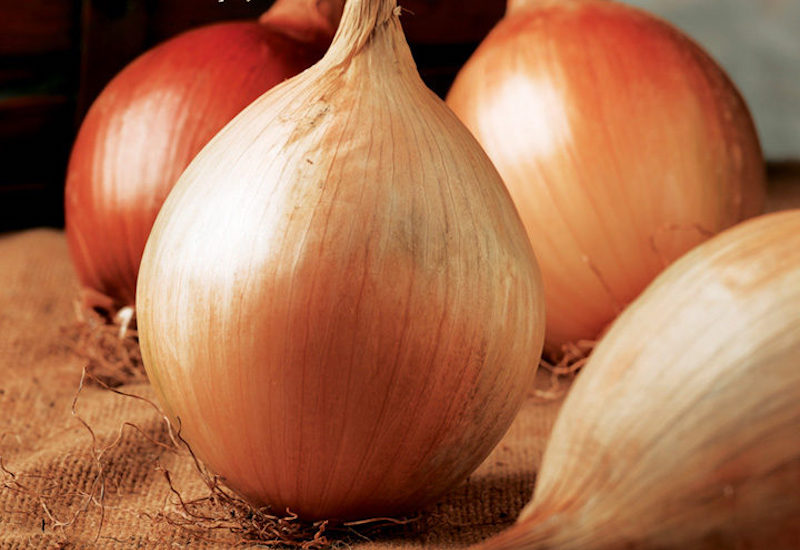
Sow a variety of onion seeds and plant out the strongest seedlings to grow on
Image: Onion seeds ‘Ailsa Craig’ from Suttons
For choice, satisfaction and maximum yield, Steve at Steve’s Seaside Life always starts off his onion crop by sowing a range of seed varieties, as he explains in his great video introducing his onion seedlings. While admitting his results aren’t always as good as he’d like, using seed means he can over-sow, then select the best seedlings to grow on for a mix of onion sizes – some large, lots of medium for storing and enough small ones for pickling. And any spindly spare seedlings can be usefully grown on as salad onions.
Muddybootz, aka Nigel Jewkes, is another fan of growing onions from seed, for ease, economy and variety. He also says they’re less likely to bolt than those grown from sets. As part of his ‘Growing Made Easy’ series, he provides an excellent step-by-step guide to growing onions, from sowing in quarter seed trays of worm compost and warming them in a propagator, to potting on, planting out and harvesting.
Although seeds can be tricky to handle, gardening bloggers Eli and Kate point out that you’ll have a wider variety of onion types to choose from if you opt for seeds rather than sets. In their excellent guide to growing onions from seed, they explain that sowing your seeds indoors during the late winter or early spring gives them a head start on the growing season. Just be sure to transplant them outside when the weather warms up.
Best advice on planting out onions
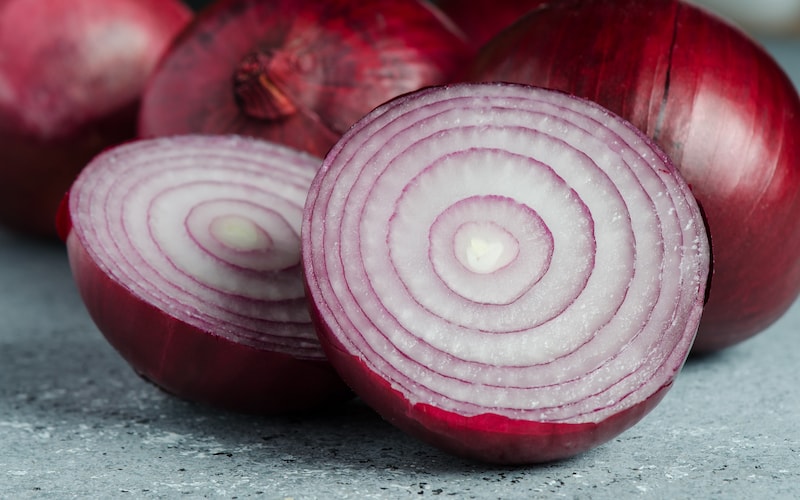
Plant alternate red and white onions for an attractive display and delicious crop
Image: Onion sets ‘Red Ray’ from Suttons
Neat straight rows of onions look really attractive in the veg bed, especially if you alternate white and red varieties when you plant them out, according to Carol, aka The Sunday Gardener. In her delightful step-by-step guide to growing onions with complementary video she also points out that onions make great companion plants, deterring carrot fly and slugs from other veg crops planted nearby.
Claire, from Claire’s Allotment, started her onion sets off in cardboard toilet roll tubes in the greenhouse. She leaves the sets in the tubes when they go in the ground in her concise and easy-to follow video: Planting out my onions. She plants them about 4in apart in a raised bed, explaining that the cardboard will biodegrade, giving the onion bulbs plenty of room to swell up. And she reminds us to weed and water them on a regular basis.
In her informative and engaging video planting autumn onions, Liz Zorab at Byther Farm recommends planting onion sets in rows and covering them in two inches of soil. As well as sharing her top tips for planting onions the right way up, she demonstrates how to reduce weeds by placing cardboard strips in between each row. If you live in a particularly windy area, covering the cardboard with woodchips or weighing it down with bricks will provide an extra layer of protection.
Growing onions alongside other vegetables is another good way to make the most of the space you have. When Jenny from @jenny.roozel realised that her onions would have to “share a bed with the brassicas”, she was inspired to create a “soup plot” by planting onions, garlic, leeks, potatoes, parsnips and swedes. What a great idea!
A serious allotment grower, Cliff at Castle Hill Garden shares his onion planting techniques in this garden update video from his plot in Nottinghamshire. He grows from seed and plants his onions out – cutting uniform holes with a bulb planter – in a double dug bed that has a deep manure base for the roots to feed on.
Best advice on onion problems, pests and diseases
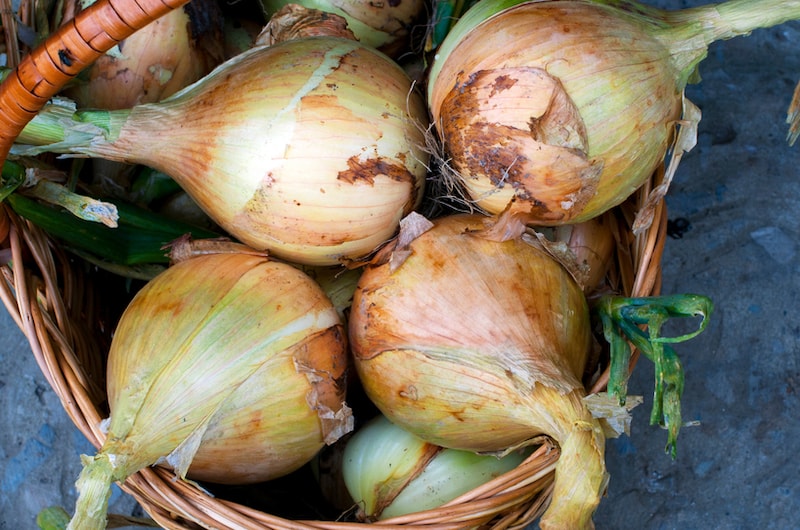
Prevent your prize onions from succumbing to common problems
Image: Shutterstock
While onions are usually trouble-free plants, John of Allotment and Gardens – who shares plenty of excellent onion growing tips – flags up a few hazards to watch out for in his eye-opening article: Onion Pests, Diseases & Problems. He explains how to recognise onion fly, white rot, leaf miner, rust, mould and mildew; provides advice on what to do if your plant starts to bolt; and shares practical tips for putting off pesky pigeons.
If you’ve had problems with onion or shallot bulbs rotting in wet soil, like Hayley at @hayleys_lottie_haven, you could try her trick of starting sets off in small individual pots of multipurpose compost in the greenhouse. She plants hers out after they’ve developed a really healthy root system.
Erica over at Erica’s Little Welsh Garden also offers plenty of tips to help you grow healthy onions. In her video on planting onion sets, she explains how to identify rust, which is caused by an excess of nitrogen in the soil. To avoid this problem, Erica suggests only adding a small amount of nitrogen-rich manure when you plant your onions.
At Marie and Jim’s allotment, @4_muddy_boots, they suffer from onion white rot. To prevent it from spoiling their crop, they dig a trench and plant their onions on a bed of coir. They say that planting in coir gives the bulbs a sterile base on which to grow. “It’s worked for us the past couple of years.” Visit their Instagram page for more helpful tips.
Best advice on harvesting and storing onions

Drying your onions well before storage helps them keep longer
Image: Onion Seeds – Senshyu Semi-Globe Yellow from Suttons
Knowing when and how to harvest and dry your onions is really important if you want them to store well through winter. Tony of Simplify Gardening charts the process thoroughly in his video guide. He says to choose a bright day without rain to lift your onions after their necks have flopped over, being very careful not to pull and damage them. Then remove the soil from the roots before letting them dry out in the sun.
If you’re harvesting your onions in July and August, Marie from Plews Garden Design recommends checking whether the onion leaves have turned dry and yellow and the tops have bent over naturally, as this is another sure sign that the crop is ready. If she’s lifting her onions on a dry day, Marie simply leaves them on the earth to dry. If it’s raining, she has to dry them under cover.
Ionela from @back_to_the_origins_il keeps an eye on her onions and, as soon as the leaves begin to bend, she cuts the flavoursome green tops off and slices them up like spring onions. Leaving nothing to go to waste, she bags these up to keep in the freezer until needed. The onion bulbs remain in the ground for another week or two before she harvests them.
Where you place your onions to dry depends on space and weather. When Debbie over at @mrsbeesgarden created a makeshift wooden drying rack for her onions, she managed to keep the rain off by adding some removable greenhouse staging made from pipe and polythene. Take a look at how she dries her impressive haul.
Francesca from @frangrowsfood built her own DIY onion drying rack to hang under the BBQ hut out of the rain. Made from two old greenhouse shelves, she suspended them using garden twine to cure her crop ready for storage. “It does mean that outdoor cooking is currently off limits though,” she added. Take a look at the image to see her clever drying rack (and very cool outdoor kitchen!)
Once your onions are dry, you’ll probably want to store some. Braiding your onions or shallots for winter storage can be hugely satisfying, as illustrated by Katrina of @homegrown.garden in a picture that contrasts her plaited shallot string with her own hair braid. She was particularly pleased with her crop – as they don’t often thrive in her soil for some reason.
Braiding onions into an onion string is also an effective storage solution because it keeps the air circulating. Since he began using this technique, Dan of Allotment Diary has found that his crop of onions keeps for longer. Fancy trying this yourself? Check out his step-by-step video guide How to String Onions for Better Storage.
If braiding sounds too much like hard work, Mothin Ali from My Family Garden has an alternative suggestion. In his video on harvesting and storing onions, Mothin recommends storing your onions in light stackable grocery trays that allow the air to circulate and prevent rotting. His top tips? Brush off any dirt and trim the stems before storing the onions, but don’t remove any flaky outer skin, as this provides extra protection.
So, now you know your onions a little better, put some of this great advice from the experts into action and you could be harvesting your own crop this summer, with plenty of onions to keep you going through the rest of the year.
Lead image: Onion Seeds – F1 Santero from Suttons
Last Updated on October 31, 2025 by Suttons Horticultural Team

